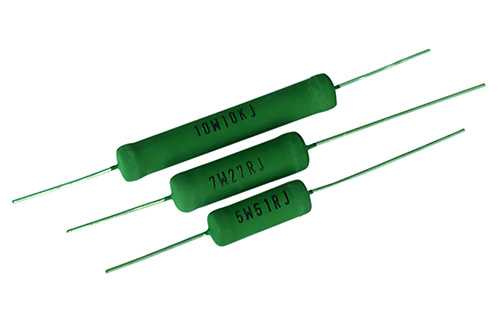Power wound resistors and the basic introduction of several resistors
The power wound resistor is a two-terminal electronic element which is made of resistor material and has a certain structure. It can limit the current passing in the circuit. Those whose resistance cannot be changed are called fixed resistors. Those with variable resistance are called potentiometers or variable resistors. The ideal resistor is linear, that is, the instantaneous current through the resistor is proportional to the applied instantaneous voltage. Some special resistors, such as thermistors, varistors, and sensing elements, have a nonlinear relationship between voltage and current. Resistors are the most widely used components in electronic circuits. They are usually divided into different series according to power and resistance values and selected by the designers of power supply circuits. The resistor in the circuit is mainly used to adjust and stabilize the current and voltage, can be used as a shunt and voltage divider, but also for the circuit to match the load.
According to the requirements of the circuit, it can also be used to amplify the negative feedback or positive feedback circuit, voltage-current conversion, input overload voltage or current protection components, and can be composed of RC circuit as oscillating, filtering, bypass, differential, integral and time constant components. Low-power carbon film resistors are usually made of carbon film enclosed in a plastic case, while power wound resistors are usually made of wire wound by wrapping a high resistivity metal wire around a porcelain core.

If a resistor has a resistance value close to zero ohm (for example, a large cross-section wire between two points), the resistor does not impede the current, and the circuit connecting the resistor is short-circuited and the current is infinite. If a resistor has an infinite or very large resistance, the circuit connected in series to the resistor may be considered open, with zero current. The resistors commonly used in industry fall somewhere between these two extremes in that they have a resistance that allows a current to pass through, but not as large as in a short circuit. The current limiting action of a resistor is similar to that of a small diameter pipe connected between two large diameter pipes to limit the flow of water.
Resistance, often abbreviated to R, is a basic property of conductors, which is related to the size, material and temperature of the conductor. Ohm's law states that I=V/R, then R=V/I, and the basic unit of resistance is the ohm, expressed by the Greek letter "Ω", which is defined as the resistance value of one ampere of current generated by applying a voltage of one volt to a conductor. The main function of a resistor is to obstruct the flow of electric current. In fact, the word "resistor" refers to a property, and the resistance commonly used in electronics is a component such as a resistor.
“Recommended reading”
- What are the characteristics of aluminum resistors?
- 电阻器如何运行和工作?
- How to choose the resistance value of the charging resistor?
- 什么是导致预充电阻损坏的原因?
- How to improve the aluminum shell resistance compliance product quality!
- Stable and adjustable high power corrugated and wound resistors!
- What are the types and special features of high power wirewound resistors ?
- Application and characteristics of cement resistance
- Precautions when using resistors
- Classification and main characteristic parameters of resistors
Recommended information
- 正阳兴生产的负载箱应用的领域和特点!
- ZENITHSUN Production Site-1
- ZENITHSUN Production Site-2
- ZENITHSUN Production Site-3
- ZENITHSUN Production Site-4
- Load Bank Assembly Site -1
- Load Bank Assembly Site -2
- ZENITHSUN Load Banks Assembly Site-3
- Load Banks Batch Assembly Site-4
- Load Bank Assembly Site -5




